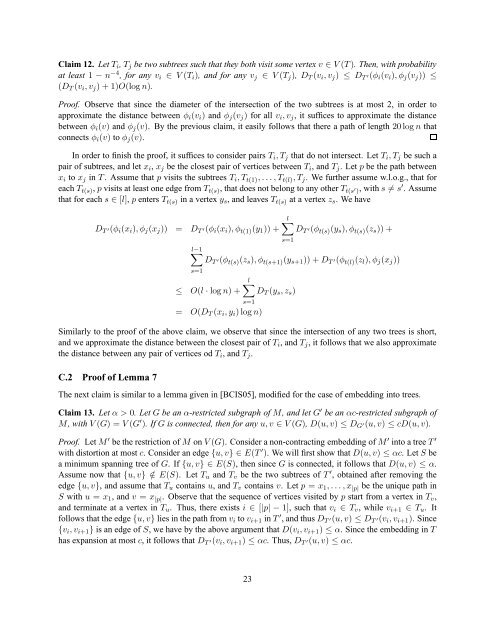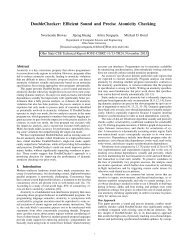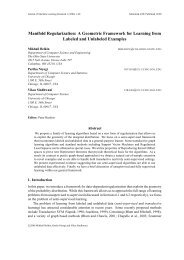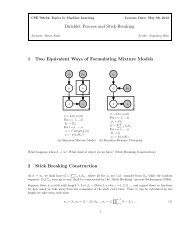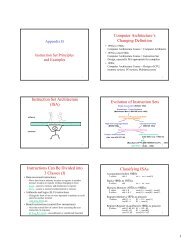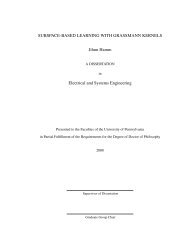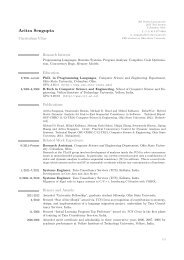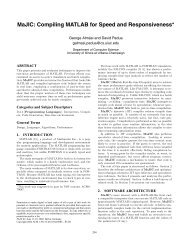Approximation Algorithms for Embedding General Metrics Into Trees
Approximation Algorithms for Embedding General Metrics Into Trees
Approximation Algorithms for Embedding General Metrics Into Trees
You also want an ePaper? Increase the reach of your titles
YUMPU automatically turns print PDFs into web optimized ePapers that Google loves.
Claim 12. Let T i , T j be two subtrees such that they both visit some vertex v ∈ V (T). Then, with probability<br />
at least 1 − n −4 , <strong>for</strong> any v i ∈ V (T i ), and <strong>for</strong> any v j ∈ V (T j ), D T (v i ,v j ) ≤ D T ′(φ i (v i ),φ j (v j )) ≤<br />
(D T (v i ,v j ) + 1)O(log n).<br />
Proof. Observe that since the diameter of the intersection of the two subtrees is at most 2, in order to<br />
approximate the distance between φ i (v i ) and φ j (v j ) <strong>for</strong> all v i ,v j , it suffices to approximate the distance<br />
between φ i (v) and φ j (v). By the previous claim, it easily follows that there a path of length 20log n that<br />
connects φ i (v) to φ j (v).<br />
In order to finish the proof, it suffices to consider pairs T i ,T j that do not intersect. Let T i ,T j be such a<br />
pair of subtrees, and let x i , x j be the closest pair of vertices between T i , and T j . Let p be the path between<br />
x i to x j in T . Assume that p visits the subtrees T i ,T t(1) ,... ,T t(l) ,T j . We further assume w.l.o.g., that <strong>for</strong><br />
each T t(s) , p visits at least one edge from T t(s) , that does not belong to any other T t(s ′ ), with s ≠ s ′ . Assume<br />
that <strong>for</strong> each s ∈ [l], p enters T t(s) in a vertex y s , and leaves T t(s) at a vertex z s . We have<br />
D T ′(φ i (x i ),φ j (x j )) = D T ′(φ i (x i ),φ t(1) (y 1 )) +<br />
l∑<br />
D T ′(φ t(s) (y s ),φ t(s) (z s )) +<br />
s=1<br />
∑l−1<br />
D T ′(φ t(s) (z s ),φ t(s+1) (y s+1 )) + D T ′(φ t(l) (z l ),φ j (x j ))<br />
s=1<br />
≤ O(l · log n) +<br />
l∑<br />
D T (y s ,z s )<br />
s=1<br />
= O(D T (x i ,y i )log n)<br />
Similarly to the proof of the above claim, we observe that since the intersection of any two trees is short,<br />
and we approximate the distance between the closest pair of T i , and T j , it follows that we also approximate<br />
the distance between any pair of vertices od T i , and T j .<br />
C.2 Proof of Lemma 7<br />
The next claim is similar to a lemma given in [BCIS05], modified <strong>for</strong> the case of embedding into trees.<br />
Claim 13. Let α > 0. Let G be an α-restricted subgraph of M, and let G ′ be an αc-restricted subgraph of<br />
M, with V (G) = V (G ′ ). If G is connected, then <strong>for</strong> any u,v ∈ V (G), D(u,v) ≤ D G ′(u,v) ≤ cD(u,v).<br />
Proof. Let M ′ be the restriction of M on V (G). Consider a non-contracting embedding of M ′ into a tree T ′<br />
with distortion at most c. Consider an edge {u,v} ∈ E(T ′ ). We will first show that D(u,v) ≤ αc. Let S be<br />
a minimum spanning tree of G. If {u,v} ∈ E(S), then since G is connected, it follows that D(u,v) ≤ α.<br />
Assume now that {u,v} /∈ E(S). Let T u and T v be the two subtrees of T ′ , obtained after removing the<br />
edge {u,v}, and assume that T u contains u, and T v contains v. Let p = x 1 ,... ,x |p| be the unique path in<br />
S with u = x 1 , and v = x |p| . Observe that the sequence of vertices visited by p start from a vertex in T v ,<br />
and terminate at a vertex in T u . Thus, there exists i ∈ [|p| − 1], such that v i ∈ T v , while v i+1 ∈ T u . It<br />
follows that the edge {u,v} lies in the path from v i to v i+1 in T ′ , and thus D T ′(u,v) ≤ D T ′(v i ,v i+1 ). Since<br />
{v i ,v i+1 } is an edge of S, we have by the above argument that D(v i ,v i+1 ) ≤ α. Since the embedding in T<br />
has expansion at most c, it follows that D T ′(v i ,v i+1 ) ≤ αc. Thus, D T ′(u,v) ≤ αc.<br />
23


